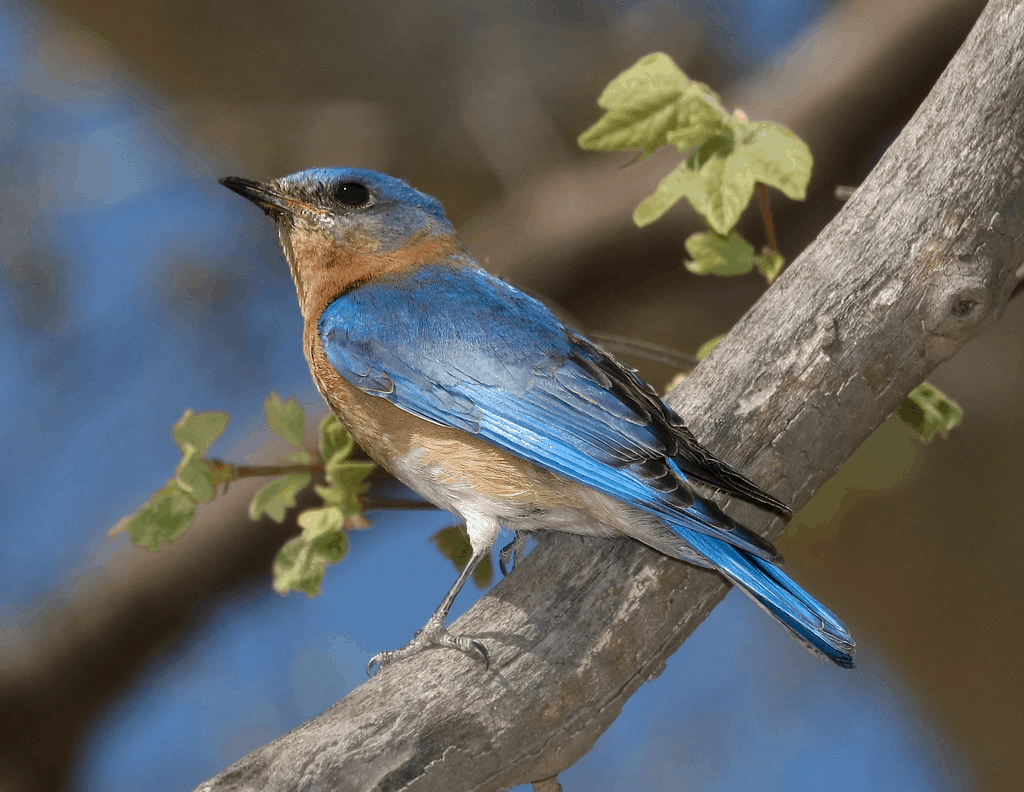You have probably heard that bluebirds need your help. Today, because of high competition for nesting sites from non-native species like house sparrows, bluebirds rely greatly on man-made birdhouses to build nests and raise young. While I love putting up and monitoring birdhouses to support the bluebird population, I’ve started to wonder how much trouble bluebirds are really in today? So, I did some research on the current bluebird population and, in this article, I hope to answer the following question: are bluebirds endangered?

Are bluebirds endangered or not?
So, are bluebirds endangered? The short answer is “no.” None of the three species of bluebirds in North America are currently classified as “endangered” by the International Union for Conservation of Nature. The IUCN’s “Red List of Threatened Species” is the world’s most comprehensive list on the conservation status of animal species. So, to show up on this list as “vulnerable,” “threatened,” or “endangered” would be a big deal for bluebirds. Luckily, all three North American species of bluebirds fall safely outside of this classification on the Red List.
Note: The three species of bluebirds in North America are Eastern Bluebirds, Western Bluebirds, and Mountain Bluebirds.
What would it take for bluebirds to be considered “endangered?”
There are five criteria that the IUCN takes into consideration when deciding to classify a species as endangered on the Red List (see their full list of criteria in this official publication). Two relevant criteria for bluebirds are (1) total population size, and (2) geographic range. Let’s see what it would take for any of the three bluebird species to be classified as “endangered” based on these two criteria.
Total population needed to be considered endangered:
According to the IUCN, the total population of a species needs to fall to “fewer than 250 mature individuals” in order for the animal to be classified as “endangered.” Thankfully, the bluebird population is far from reaching this low number of 250 mature individuals. (I’ll cover the current populations estimates for the three species of North American bluebirds in a table below.)
However, if the bluebird population of a certain species were to fall below 2,500 mature adults, and scientists also suspected that the population would continue decreasing by more than 20% in the following five years, then these two factors together would be enough to classify the bluebird species as “endangered.” Thankfully again, bluebirds don’t come close to reaching the low population of 2,500 either.
Geographic range requirements to be considered endangered:
A species will also be chosen for “endangered” status by looking at its “extent of occurrence” (EOO). This term basically refers to the amount of space in which a species can be found – how far the species spreads throughout the country or globe. According to the IUCN, if a species has an EOO that is less than 500km² and its geographic range is drastically fragmented or in rapid decline, the species will be labeled “endangered.” Bluebirds miss the mark here too. The Western Bluebird species alone, which occupies the smallest geographic area of the three species, has an EOO of 3,790,000km² – much higher than 500km².
So, based on their population size and the geographic range that they occupy, bluebirds are not considered to be “endangered.” So what does the bluebird population look like?
What is the current bluebird population?
Below is the estimated population size of the three species of North American bluebirds:
| Photo | Species | Population |
Photo by Kelly Colgan Azar License: CC BY-ND 2.0 | Eastern Bluebird Sialia sialis | 22 million |
Photo by NatureNation License: CC BY-ND 2.0 | Western Bluebird Sialia mexicana | 6.7 million |
Photo by goingslo Licensed: CC BY 2.0 | Mountain Bluebird Sialia currucoides | 4.6 million |
This information comes from the “Partners in Flight” population estimates database from 2019 (view the source material on their site here).
If they’re not endangered, what is the current conservation status of bluebirds?
So, since each species of bluebirds has a population far too high to be considered “endangered,” how are bluebirds currently classified on the IUCN Red List? At this time, eastern bluebirds, western bluebirds, and mountain bluebirds are all listed as species of “Least Concern” according to the IUCN (find this on their website).
All three species of bluebirds are marked as “LC” on the spectrum below:
Happily, all three species of bluebirds are three levels removed from being endangered (EN) and two levels removed from being vulnerable (VU) on this international list. You can check each species’ respective conservation status on the IUCN’s “Red List of Threatened Species” by clicking the links below:
Since the “Least Concern” status only applies to the three main species as a whole, are any of the subspecies of bluebirds in danger on a smaller scale?
Subspecies of bluebirds that are vulnerable or endangered
While none of the three species of bluebirds are classified as vulnerable or endangered, certain subspecies of bluebirds might show up from time to time as “vulnerable” in different states and jurisdictions. This might be alarming at a local or regional level, but probably isn’t cause for concern for the species as a whole. Let’s look into why a subspecies being “vulnerable” might not be as concerning as it sounds.
A vulnerable subspecies: The Azure Bluebird
One example of a vulnerable subspecies occurs in Arizona. The “Azure Bluebird,” a subspecies of the Eastern Bluebird that inhabits Arizona and Mexico, is currently classified as “vulnerable” by the Arizona Game and Fish Department. (Find this info on their website here).
Why is this subspecies listed as “vulnerable” in Arizona?
The Arizona Game and Fish Department labels a subspecies as “vulnerable” if the following is true:
- The subspecies is rare or uncommon in the sub-nation (i.e. state), OR
- If the subspecies is found in a restricted range (even if it is abundant in some locations), OR
- If there are other factors making the subspecies vulnerable to extirpation
(Source: Arizona Game and Fish Dept.)
So, the Azure Bluebird is listed as “vulnerable” by the state of Arizona, but the reasons that Arizona gives them that status probably aren’t a red flag for all of Eastern Bluebirds. It’s probably not even a red flag for the population of Azure Bluebirds as a whole. Azure Bluebirds are considered vulnerable in this particular region of the country due to their restricted range and because of the possibility of extirpation (disappearing from the region). While this might be alarming for Arizona residents who are seeing fewer and fewer of these bluebirds, it doesn’t necessarily mean that the population of Azure Bluebirds is decreasing overall or that their total geographic range is decreasing. It could simply be a regional issue that is a concern in Arizona.
So, while some subspecies of bluebirds might be listed in certain places as “vulnerable” or “threatened,” that doesn’t necessarily imply a decline in the bluebird population as a whole. We need to look at the entire population of the three bluebird species, which we saw above, to get a full and accurate picture.
We know from the table above that bluebird populations are too high for the three species to be considered “endangered” or even “vulnerable.” But what does the future look like for the bluebird population?
Is the bluebird population increasing or decreasing?
Even though the population of eastern bluebirds decreased during the early 20th century due to high competition from non-native birds like house sparrows and European starlings (see Cornell Lab of Ornithology), thanks to conservation efforts, their numbers are increasing today! The same is true for western and mountain bluebirds. All three species of bluebirds have been on an upward trend and have increasing populations according to the IUCN (see their data here). So, where does that leave us today?
Do bluebirds still need our help?
Since bluebirds are considered to be species of “Least Concern” by the IUCN and their populations are increasing, do bluebirds even need our help anymore? According to many organizations, like the North American Bluebird Society, they do. The thriving bluebird populations that we see today are likely thanks to people like you and me who choose to mount and monitor bluebird houses to provide homes for these wonderful creatures.
Scarce natural nesting sites and high competition from non-native species are still a reality for bluebirds, so providing and monitoring man-made nesting sites (bird houses) is essential for maintaining a thriving bluebird population. Luckily, what’s good for bluebirds is also a fun hobby for people who have the space to put up a bird house.
If you’d like to learn more about bluebirds, putting up bluebird houses, or attracting these wonderful birds to your yard, find out more on this site.
Thanks for visiting BluebirdLandlord.com.

